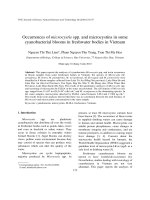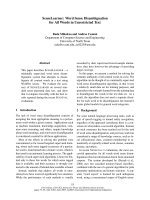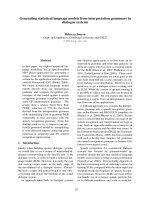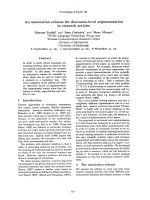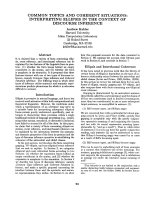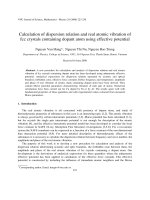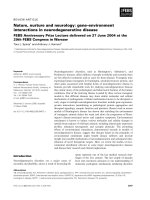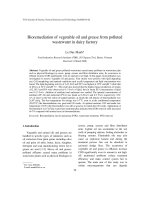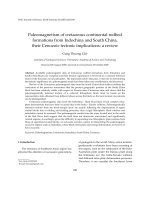Báo cáo " Bioremediation of vegetable oil and grease from polluted wastewater in dairy factory " doc
Bạn đang xem bản rút gọn của tài liệu. Xem và tải ngay bản đầy đủ của tài liệu tại đây (150.02 KB, 7 trang )
VNU Journal of Science, Natural Sciences and Technology 24 (2008) 56-62
56
Bioremediation of vegetable oil and grease from polluted
wastewater in dairy factory
Le Duc Manh*
Food Industries Research Institute (FIRI), 301 Nguyen Trai, Hanoi, Vietnam
Received 31 March 2008
Abstract. Vegetable oil and grease polluted wastewater caused many problems in wastewater plan
such as physical blockages in sewer, pump, screens and filter distributor arms. Its occurrence in
effluent increase COD significantly even its amount is not high. In this paper, bioremediation was
investigated to remove vegetable oil and grease. Four strains were positive with lipid degrading
test. Cell morphology and optimal conditions such as pH, temperature anf lipid concentration was
found. The lipid-degrading activity of A12, B13 and D15 was highest at 30
o
C and pH 7 while that
of D14 is at 34
o
C and pH 7.5 . The result also showed that the highest lipase production of strains
A12, B13 and D14 were observed at 0.1 %w/v of lipid, but for strain E15 concentration of lipid
was 0.15 %w/v. Addition of antifoam and surfactant was studied. The optimal concentration of
antifoam (CF-18) and surfactant (PVA) was found as 0.4%w/v and 0.2 %w/v respectively. 10%
w/v of straw in the best ration of support particle, at which the cell density of bioremediatior was
2x10
8
cfu/g. The best temperature for storage was 5-7
o
C, even so at the conditioned temperature
(20-25
o
C) the bioremediation was good until 20 weeks. At optimal moisture 10% and under low
temperature (5-6
o
C) the bioremediator was still as good as its initial after 20 weeks. Application of
bioremediator in 25 m
3
/day wastewater treatment plan indicated that COD removal yield increased
s6-7% compared with normal case (no bioremediation).
Keywords: Bioremediation, fat-oil and grease (FOG), wastewater treatment, FOG removal.
1. Introduction
∗
∗∗
∗
Vegetable and animal oils and greases are
handled in specific types of industries such as
oil extraction from plant grains including olive
oil and palm oil mills, butter, dairy, slaughter,
detergent and soap manufacturing where fat or
grease are used [1-5]. Heavy oil and grease-
polluted effluents caused many problems in
wastewater plants such as physical blockages in
_______
∗
Tel.: 84-4-8584481.
E-mail:
sewers, pump, screens and filter distributor
arms. Lighter oil can accumulate in the wet
wells of pumping stations, fouling electrodes or
floating systems. Flammable oils may also
cause an explosion hazard and during the
treatment process fats can be absorbed to
activated sludge flocs. The occurrence of
vegetable oil and grease in effluents increase
COD significantly even its amount is not high.
All mentioned problems reduce treatment
efficiency and make control system fail to
operate. The main aim of this study was to
isolate microorganisms that can degrade
L.D. Manh / VNU Journal of Science, Natural Sciences and Technology 24 (2008) 56-62
57
vegetable oil and grease, find out the optimal
conditions to produce maximum biomass and
produce a bioremediation for vegetable oil and
grease biodegradation.
2. Materials and Methods
Medium cultures
Screening medium was Tween 20 (Tw20),
which contains per liter distilled water: 10 gram
peptone, 5 gram NaCl, 0.1 gram CaCl
2
.2H
2
O,
and 20 gram of agar. The medium was
supplemented with 1% Tween 20, and the pH
was adjusted to 7.5. Tween 20 was separately
autoclaved at 121
o
C for 20 min, and then added
before use to the sterilized medium
components. Tw20 medium was mainly used to
screen and selectively isolate bacterial strains
that can degrade Tw20 indicating their ability
for lipid biodegradation, where the fatty acids
produced as a result of Tw20 degradation react
with CaCl
2
then forming a precipitate appearing
as a zones around lipid degradable colonies.
The LMM medium contained 1.12 gram
K
2
HPO
4
, 0.48 gram KH
2
PO
4
, 5 gram NaCl, 0.1
g MgSO
4
.7H
2
O, 2.0 gram (NH
4
)
2
SO
4
and 0.001
g EDTA per liter of distilled water. Each
ingredient was separately autoclaved at 121
o
C
for 20 min before mixing, and then the medium
was supplemented with 1% soybean oil as the
natural substrate present in the raw effluent of
the investigated company. LMM was used in
the present study to investigate the ability of the
Tw20-screened strains for degradation of the
natural pollutant (soybean oil) when supplied as
the only carbon and energy source in order to
select the strains that can be effectively used in
remediation of that polluted effluent [6-10].
Three mediums TYGA, NGS and IAM
were used in this study to find out which
nutrient conditions the isolates could produce
the maximum biomass [11,12]. The TYGA
medium contained 5 gram trypton, 2.5 gram
yeast extract and 1 gram of glucose per liter of
distilled water. The medium has been sterile at
121
o
C for 15 minutes after adjusting to pH 7
separately with glucose. The NGS medium
contains per liter of distilled water: nutrient
broth 4 gram, potato starch 5 gram, glucose 8
gram and 0.5 gram of yeast extract. Glucose
was sterile separately with other components in
all above conditions. The IAM medium
contained 0.15 gram NaCOOCH
3
, 0.15 gram
glucose, 5 milliliter of vitamin solution, 10
milliliter solution A and 1 milliliter of
phosphate solution. Solution A was prepared by
mixing of 10 gram of (NH
4
)
2
SO
4
, 5 gram KCl,
5 gram MgSO
4
.7H
2
O, 2 gram CaCl
2
. 2H
2
O, 2
gram CaCO
3
and 0.05 gram of FeCl
3
.6H
2
O
with 1 liter of distilled water. The phosphate
solution contains per liter of distilled water: 124
gram Na
2
HPO
4
, 15.4 gram NaH
2
PO
4
. The IAM
medium was adjusted to pH 7,2 then sterile at
121
o
C for 15 minutes, vitamin solution was
added to medium when the temperature of
medium was about 40
o
C after sterile [13,14].
Isolation of lipid-degrading bacterial
Samples were taken at the sewers of dairy
enterprises, slaughters, food processing
enterprises and milk collections. After
collection, all samples were isolated in the lab
where it was serially diluted up to 10
-8
and
spread on solid sterile surfaces of Tw20 agar
plates as triplicate. The plates then were
incubated at 30
o
C for 24 hours. Only bacterial
strains that have ability to degrade lipid were
grown [13,15].
Lipase assay
Lipase assay was implemented by using
modified method of Nguyen Trong Can (1998)
[2]. The substrate was soybean oil instead of
olive oil.
L.D. Manh / VNU Journal of Science, Natural Sciences and Technology 24 (2008) 56-62
58
COD measurement
COD was measured as specification TCVN
6491-1999.
Total lipid analysis
Total lipid analysis was calculated by using
Roese-Gottllied (JAS-SOP 35) [15].
3. Results and Discussions
Isolation of Micro-organisms
35 strains were isolated in screening
medium Tw 20. After testing the lipid-
degrading ability of screened strains there were
4 strains as A12, B13, D14 and E15 were
positive. The precipitation of free fatty acids
with calcium give a white zone around colony
has been used for detection of lipid degrading
microorganisms and producing lipase.
Optimization of temperature
The results shown that at fixed conditions
as pH 7 the optimal temperature of isolated
strains was 30
o
C for A12, B13 and E15 when
D14 produced highest lipid-degrading capacity
at 34
o
C. At the optimal temperature lipase
activities were 1.79, 1.43, 0.94 and 1.5 for A12,
B13, E15 and D14 respectively.
Optimization of pH
At optimal temperature condition of strains
and after 24 hour of incubation, the results
indicated that the activity of lipid degradation
of strain D14 was at pH 7.5 while the others
were at pH 7. The lipase activity of D14 was
0.97, and that of A12, B13 and E15 were 1.66,
1.43 and 1.51 respectively.
Optimization of FOG concentration
Five FOG concentrations were tested to find
out the optimal substrate concentration for
lipolytic activity. This range of concentration
was a common range of FOG concentration in
wastewater of food processing companies. The
results confirmed that the at 0.1% by weight of
soybean oil the highest degradative activity of
A12, B13 and D14 was observed as 1.79, 1.43
and 0.91 respectively, while E15 produced the
highest activity at 0.15%.
Extra-cellular lipase producing by
microoganisms was controlled by many factors
such as initial pH, growth temperature, and type
and substrate concentration. In this paper the
optimal temperature and pH were investigated
as shown by other reports (Stams A.G etc 1997
and Jaeger, K.E etc 1994) [1,8]. The results also
indicated that the lower concentration of
soybean oil (play the role of carbon source) the
lower lipolytic activities were observed, this
may due to the lack of substrate for
microorganism growth. At higher optimal
concentration of soybean oil lipid activity of
strains was reduced; this can be explained by
the inhibition of oxygen dissolve at high
concentration of soybean oil.
Combination of strains
In facts, the wastewater treatment plan
worked on varied conditions as pH, substrate
concentration and operation temperature. To
overcome this situation the combination of
isolated strains was investigated. The fixed
condition as pH 7, 30
o
C and 0.1% of soybean
oil was used. Ratios by weight of A12, B13,
D14 and E15 such as 1:1:1:1, 1:2:1:2, 2:1:2:1,
2:2:1:1, 1:1:2:2 respectively were tested. The
results shown that lipid-degrading activity of
mixed strains was highest at ration 1:1:1:1
while the lowest activity was observed at ratio
2:1:2:1(figure 1). The explanation of this
phenomenon may be the inhibition or
promotion of mixed strains in fixed condition.
L.D. Manh / VNU Journal of Science, Natural Sciences and Technology 24 (2008) 56-62
59
Fig. 1. Lipid degrading activity of mixed ratios.
Addition of antifoam and surfactant
CF-18 is common antifoam using in
wastewater treatment system. In this study, the
optimal concentration of CF-18 was
investigated. The result (Table 1) showed that
increasing of CF-18 concentration caused
increasing of cell density. The maximum value
of cell density was observed at 0.4 %w/v. With
the higher concentration of CF-18 the cell
density was decreased and it was quite inhibited
at CF-18 of 1.5% w/v. This can be explained by
the increasing of surface contact between
phases at low concentration while at high
concentration CF-18 may inhibit cells and
reduce the dissolvent of oxygen to water phase.
These results are similar to previous reports
(Kurita 1999, Bhumibhamon etc 2003, Daigger
etc 2003) [6,7,10].
Table 1. Effect of CF-18 to the bioremediator
CF-18 (% w/v) Blank 0,2 0,4 0,6 0,8 1,0 1,5 2,0
Cell density (10
3
CFU/ml) 151 222 259 254 182 25 2 1
Surfactants in fat polluted wastewater
treatment plays an important role, it increases
the surface contact of oil-phase and water-
phase. In this paper, PEG (polyethylene glycol)
and PVA (polyvinyl acetate) were tested.
Results (table 2) have shown that at 0.2 %w/v
of PEG cell was inhibited and no cell was
observed at 0.8%w/v. According to Cao Xuan
Thang (2004) [9] this may due to inhibition of
PEG on cell and dissolve of oxygen.
Table 2: Effect of surfactants to the bioremediator
Surfactant concentration (%w/v) Cell density x 10
3
(cfu/ml)
PEG (polyethylene glycol)
0
0.2
0.4
0.6
0.8
1
131
101
9
3
0
0
L.D. Manh / VNU Journal of Science, Natural Sciences and Technology 24 (2008) 56-62
60
PVA (polyvinyl acetate)
0
0.1
0.2
0.3
0.4
0.5
148
158
159
180
187
191
Results in table 2 also showed that PVA not
significantly effect to cell. The cell density was
increased even PVA added. The increasing of
cell density may due to attachment of cell to the
PVA network. Optimal concentration was
advised as 0.2 %w/v.
Storage and application of bioremediator
Straw was used for microorganism
immobilization. After milling, drying and
sterile at 121
o
C for 15 minutes, 0.4% w/v of
CF-18 and 0.2 %w/v of PVA were added to
mixed starter. Mixed solution was incubated
and dried to 10% of moisture.
Table 3. Effect of concentration of straw on cell
density in bioremediator
Concentration of straw
(% w/v)
cfu/gram bioremediator
5 6 x 10
6
10 2 x 10
8
20 5 x 10
6
30 4 x 10
5
Table 3 showed the relation between
concentration of straw and cell density of
bioremediator. The results indicated that 10%
of straw was the optimal concentration at which
bioremediator has a highest cell density (2x10
8
cfu/g). When then concentration of straw was
increased the cell density was decreased. The
explanation can be the increasing of surface
when the cell concentration was assumed as a
fixed factor.
Bioremediator was dried to 8, 10 and 15%
of moisture and keep in low temperature (5-
7
o
C), conditioned temperature (20-25
o
C) and
ambient temperature (30-35
o
C). After 20 weeks
of experiments, the results (not shown)
indicated that the higher temperature and
moisture the shorter time for storage and 10% is
optimal moisture. Bioremediator can be good at
10% of moisture and in conditioned
temperature. In case of 10% of moisture and in
low temperature, the bioremediator showed the
same quality as initial.
Application on wastewater treatment system
The bioremediator was applied to 25 m
3
/day
wastewater treatment system. Properties of
effluent were controlled as 750-850 mg/l of
COD, 0.1 - 0.16 %w/v concentration of lipid.
pH was 7.0 ± 1 and ambient temperature.
Bioremediator was added to system depending
on flow rate of effluent and controlled as 0.5
%w/v and re-added after 24 hours of treatment.
The results (not showed) affirmed that COD
removal increased 6-7 % compared with normal
case (no bioremediation).
4. Conclussion
Four strains were positive with lipid
degrading test. Cell morphology and optimal
conditions such as pH, temperature anf lipid
concentration was found. The lipid-degrading
activity of A12, B13 and D15 was highest at
30
o
C and pH 7 while that of D14 is at 34
o
C and
pH 7.5. The result also showed that the highest
lipase production of strains A12, B13 and D14
were observed at 0.1 %w/v of lipid, but for
strain E15 concentration of lipid was 0.15 %
L.D. Manh / VNU Journal of Science, Natural Sciences and Technology 24 (2008) 56-62
61
w/v. Addition of antifoam and surfactant was
studied. The optimal concentration of antifoam
(CF-18) and surfactant (PVA) was found as
0.4%w/v and 0.2 %w/v respectively. 10% w/v
of straw in the best ration of support particle, at
which the cell density of bioremediatior was 2 x
10
8
cfu/g. The best temperature for storage was
5-7
o
C, even so at the conditioned temperature
(20-25
o
C) the bioremediation was good until 20
weeks. At optimal moisture 10% and under low
temperature (5-6
o
C) the bioremediator was still
as good as its initial after 20 weeks. Application
of bioremediator in 25 m
3
/day wastewater
treatment plan indicated that COD removal
yield increased s6-7% compared with normal
case (no bioremediation).
Acknowledgement
This study was supported by Ministry of
Industry and Trade, Vietnam.
References
[1] A.G. Stams, E.S.J. Oude, Understanding and
advancing wastewater treatment, Current
opinion in biotechnology 8 (1997) 328.
[2] Nguyen Trong Can, Nguyen Thi Hien, ðo Thi
Giang, Tran Thi Luyen, Enzyme technology.
Agri. publisher. 365-368. (1998) - Vietnamese
version.
[3] TCVN standards. Water quality:
Determination of the chemical oxygen demand
TCVN 6941-1999.
[4] K.E. Jaeger, S. Ransac, B.W. Dijkstra, C.
Caloson, M. Van Heuvel, O. Missit, Bacterial
lipases, FEMS Microbiology Reviews 15
(1994) 29.
[5] El-B. Ebtesam, H. E. Mohamed, E. El-Adl.
Nawal, The potentiality of free Gram- negative
bacteria for removing oil and grease from
contaminated industrial effluents, World
Journal of Microbiology & Biotechnology 21
(2005) 815.
[6] P. Kurita Kurita Handbook of Water Treatment,
the second edition, Japan, 1999, 2-43
[7] O. Bhumibhamon, K. Phattayakorn, Lipase-
producing microorganisms for use in
contaminated fat and oil kitchen wastewater
treatment, Kasetsart Journal, Natural Sciences
37 (2003) 327.
[8] K.D. Mukherjee, Plant lipases and their
application in lipid biotransformations.
Progress in. Lipid Research 33 (1994) 165.
[9] Cao Xuan Thang, Seeroong Prichanont, Napa
Siwarungsun, Extractive fermentation of,
alkaline protease by Bacillus subtilis TISTR 25
using queous two-phase system: effect of
polymer molecular weight. Regional
symposium of Chemical Engineering 2004,
Bangkok, Thailand.
[10] G. Daigger, Manual on the Cause and Control
of Activated Sludge Bulking, Foaming and
other Separation Problem. New York: Lewis
Publishers, 2003.
[11] Le Duc Manh, Cao Xuan Thang, Trinh Thanh
Ha, Nguyen Chi Thanh, Pham Thu Trang, Le
Trung Hieu, Le Thi Tham, Study on
controlling bulking sludge, Final report of
Ministry research, 2005.
[12] Metcaff and Eddy, Wastewater Engineering,
Treatment, Disposal, Reuse Inc. Mc Graw-Hill.
International Editions, 1991, pp. 359 -434.
[13] U. S. Adriana, P. Jr. Nei, Oily sludge
biotreatment, Biotechnology and Ecosystems
Department, Petrobras Research Center
(CENPES), Rio de Janeiro, Brazil, 2002.
[14] J.I. Roy, Environmental contaminants
encyclopedia oil and grease entry, National
park service, Water resource divisions, water
operations branch, Colorando, 1997.
[15] N. Kazunori, M. Masatoshi, Improvement of
treatment of thermophilic oxic process for
highly concentration lipid wastes by nutrient
supplementation, Journal of Bioscience and
Bioengineering, Vol 92, No 6 (2001) 532.
L.D. Manh / VNU Journal of Science, Natural Sciences and Technology 24 (2008) 56-62
62
Bổ trợ sinh học trong hệ thống xử lý nước thải ô nhiễm dầu
mỡ ñộng thực vật tại nhà máy chế biến sữa
Lê ðức Mạnh
Viện Công nghiệp thực phẩm, 301 Nguyễn Trãi, Hà Nội, Việt Nam
Sự có mặt của dầu mỡ ñộng thực vật gây ra rất nhiều khó khăn trong hệ thống xử lý nước thải như:
làm tắc hệ thống ống dẫn, tắc hệ thống bơm, hệ thống chắn rác và hệ thống lọc phân phối. Chỉ với một
lượng nhỏ của dầu mỡ ñộng thực vật trong nước thải có thể làm tăng ñáng kể COD dòng vào. Trong
báo cáo này là các kết quả nghiên cứu bổ trợ sinh học ñể loại bỏ dầu mỡ ñộng thực vật trong nước thải
nhà máy chế biến sữa. Bốn chủng phân lập ñược cho kết quả dương tính với khả năng phân hủy chất
béo cao. Các ñặc tính hình thái của vi sinh vật và các ñiều kiện sinh trưởng tối ưu như pH, nhiệt ñộ, và
nồng ñộ chất béo ñã ñược nghiên cứu. Các chủng A12, B13 và D15 cho hoạt lực phân hủy chất béo
cao nhất tại 30
o
C và pH 7 trong khi chủng D14 lại ñạt giá trị cao nhất tại 34
o
C và pH 7,5. Kết quả
nghiên cứu cho thấy khả năng sinh tổng hợp lipaza của các chủng A12, B13 và D14 cao nhất ở nồng
ñộ 0,1 % chất béo, nhưng chủng E15 lại quan sát thấy nồng ñộ tối ưu là 0,15 %. Kết quả nghiên cứu
bổ sung chất chống tạo bọt và chất hoạt ñộng bề mặt cho thấy 0,4 % chất chống tạo bọt CF-18 và 0,2
% chất hoạt ñộng bề mặt PVA là nồng ñộ tối ưu. Tỉ lệ 10% chất ñệm vỏ trấu nghiền cho mật ñộ tế bào
cao nhất (2x10
8
cfu/g) của chế phẩm là tỉ lệ tối ưu. Nhiệt ñộ bảo quản tốt nhất là 5-7
o
C, mặc dù vậy
nếu ở nhiệt ñộ 20 -25
o
C chế phẩm có thể bảo quản ñược tốt sau 14 tuần ở ñộ ẩm 10%. Kết quả cũng
cho thấy ở ñộ ẩm 10% và nhiệt ñộ bảo quản 5-7
o
C thì sau 20 tuần chế phẩm vẫn có chất lượng tốt như
ban ñầu. Ứng dụng bổ trợ sinh học vào hệ thống 25 m
3
/ ngày ñêm trong 3 tháng, kết quả là hiệu suất
xử lý theo COD tăng 6-7% so với không dùng phương pháp bổ trợ sinh học
Từ khóa: Bổ trợ sinh học, dầu mỡ ñộng thực vật, xử lý nước thải, loại bỏ chất béo.
